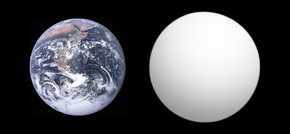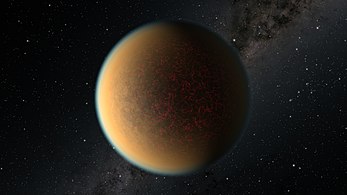| Revision as of 16:31, 27 June 2021 editCitation bot (talk | contribs)Bots5,445,081 edits Alter: title, template type. Add: eprint, class, s2cid, bibcode, arxiv, doi, page, issue, volume, journal, authors 1-1. Removed parameters. Some additions/deletions were parameter name changes. | Use this bot. Report bugs. | Suggested by Headbomb | Linked from Misplaced Pages:WikiProject_Academic_Journals/Journals_cited_by_Wikipedia/Sandbox | #UCB_webform_linked 9/35← Previous edit |
Revision as of 16:39, 27 June 2021 edit undoHeadbomb (talk | contribs)Edit filter managers, Autopatrolled, Extended confirmed users, Page movers, File movers, New page reviewers, Pending changes reviewers, Rollbackers, Template editors454,667 edits ceNext edit → |
| Line 29: |
Line 29: |
|
|
|
|
|
==Atmosphere== |
|
==Atmosphere== |
|
In April 2017, a hydrogen-dominated atmosphere was claimed to have been detected around Gliese 1132 b.<ref>{{cite web|url = https://phys.org/news/2017-04-atmosphere-super-earth.html|title = Atmosphere around super-Earth detected|website=Phys.Org|date = April 6, 2017|access-date = April 6, 2017}}</ref><ref name="Southworth2017"/> However, subsequent, more precise work ruled out the claim.<ref name="Diamond-Lowe2018"/> Instead, in 2021 detection of a hazy hydrogen atmosphere without helium but with the admixture ] and ] (implying substantial underlying free ] in the mix, at around 8.9% of the atmosphere) was claimed.<ref>{{cite journal|arxiv=2103.05657|year=2021|title=Detection of an Atmosphere on a Rocky Exoplanet|doi=10.3847/1538-3881/abe879|last1=Swain|first1=Mark R.|last2=Estrela|first2=Raissa|last3=Roudier|first3=Gael M.|last4=Sotin|first4=Christophe|last5=Rimmer|first5=Paul B.|last6=Valio|first6=Adriana|last7=West|first7=Robert|last8=Pearson|first8=Kyle|last9=Huber-Feely|first9=Noah|last10=Zellem|first10=Robert T.|journal=The Astronomical Journal|volume=161|issue=5|page=213|bibcode=2021AJ....161..213S|s2cid=232170188}}</ref> However, two subsequent studies found no evidence for molecular absorption in the HST WFC3 Spectrum of GJ 1132 b. Instead, the spectrum was found to be flat,<ref>{{cite journal|last1=Mugnai|first1=Lorenzo V.|last2=Modirrousta-Galian|first2=Darius|last3=Edwards|first3=Billy|last4=Changeat|first4=Quentin|last5=Bouwman|first5=Jeroen|last6=Morello|first6=Giuseppe|last7=Al-Refaie|first7=Ahmed|last8=Baeyens|first8=Robin|last9=Bieger|first9=Michelle Fabienne|last10=Blain|first10=Doriann|last11=Gressier|first11=Amélie|date=2021-04-05|title=ARES.* V. No Evidence for Molecular Absorption in the HST WFC3 Spectrum of GJ 1132 B|journal=The Astronomical Journal|volume=161|issue=6|page=284|doi=10.3847/1538-3881/abf3c3|arxiv=2104.01873|bibcode=2021AJ....161..284M|s2cid=233025360}}</ref><ref>{{cite arxiv|last1=Libby-Roberts|first1=Jessica E.|last2=Berta-Thompson|first2=Zachory K.|last3=Diamond-Lowe|first3=Hannah|last4=Gully-Santiago|first4=Michael A.|last5=Irwin|first5=Jonathan M.|last6=Kempton|first6=Eliza M.-R.|last7=Rackham|first7=Benjamin V.|last8=Charbonneau|first8=David|last9=Desert|first9=Jean-Michel|last10=Dittmann|first10=Jason A.|last11=Hofmann|first11=Ryan|date=2021-05-21|title=The Featureless HST/WFC3 Transmission Spectrum of the Rocky Exoplanet GJ 1132b: No Evidence For A Cloud-Free Primordial Atmosphere and Constraints on Starspot Contamination|class=astro-ph.EP|eprint=2105.10487}}</ref> which is more consistent with our current understanding of ]. |
|
In April 2017, a hydrogen-dominated atmosphere was claimed to have been detected around Gliese 1132 b.<ref>{{cite web|url = https://phys.org/news/2017-04-atmosphere-super-earth.html|title = Atmosphere around super-Earth detected|website=Phys.Org|date = April 6, 2017|access-date = April 6, 2017}}</ref><ref name="Southworth2017"/> However, subsequent, more precise work ruled out the claim.<ref name="Diamond-Lowe2018"/> Instead, in 2021 detection of a hazy hydrogen atmosphere without helium but with the admixture ] and ] (implying substantial underlying free ] in the mix, at around 8.9% of the atmosphere) was claimed.<ref>{{cite journal|arxiv=2103.05657|year=2021|title=Detection of an Atmosphere on a Rocky Exoplanet|doi=10.3847/1538-3881/abe879|last1=Swain|first1=Mark R.|last2=Estrela|first2=Raissa|last3=Roudier|first3=Gael M.|last4=Sotin|first4=Christophe|last5=Rimmer|first5=Paul B.|last6=Valio|first6=Adriana|last7=West|first7=Robert|last8=Pearson|first8=Kyle|last9=Huber-Feely|first9=Noah|last10=Zellem|first10=Robert T.|journal=The Astronomical Journal|volume=161|issue=5|page=213|bibcode=2021AJ....161..213S|s2cid=232170188}}</ref> However, two subsequent studies found no evidence for molecular absorption in the HST WFC3 Spectrum of GJ 1132 b. Instead, the spectrum was found to be flat,<ref>{{cite journal|last1=Mugnai|first1=Lorenzo V.|last2=Modirrousta-Galian|first2=Darius|last3=Edwards|first3=Billy|last4=Changeat|first4=Quentin|last5=Bouwman|first5=Jeroen|last6=Morello|first6=Giuseppe|last7=Al-Refaie|first7=Ahmed|last8=Baeyens|first8=Robin|last9=Bieger|first9=Michelle Fabienne|last10=Blain|first10=Doriann|last11=Gressier|first11=Amélie|date=2021-04-05|title=ARES.* V. No Evidence for Molecular Absorption in the HST WFC3 Spectrum of GJ 1132 b|journal=The Astronomical Journal|volume=161|issue=6|page=284|doi=10.3847/1538-3881/abf3c3|arxiv=2104.01873|bibcode=2021AJ....161..284M|s2cid=233025360}}</ref><ref>{{cite arxiv|last1=Libby-Roberts|first1=Jessica E.|last2=Berta-Thompson|first2=Zachory K.|last3=Diamond-Lowe|first3=Hannah|last4=Gully-Santiago|first4=Michael A.|last5=Irwin|first5=Jonathan M.|last6=Kempton|first6=Eliza M.-R.|last7=Rackham|first7=Benjamin V.|last8=Charbonneau|first8=David|last9=Desert|first9=Jean-Michel|last10=Dittmann|first10=Jason A.|last11=Hofmann|first11=Ryan|date=2021-05-21|title=The Featureless HST/WFC3 Transmission Spectrum of the Rocky Exoplanet GJ 1132b: No Evidence For A Cloud-Free Primordial Atmosphere and Constraints on Starspot Contamination|class=astro-ph.EP|eprint=2105.10487}}</ref> which is more consistent with our current understanding of ]. |
|
|
|
|
|
==Gallery== |
|
==Gallery== |
It has been called "one of the most important planets ever discovered beyond the Solar System": Due to its relative proximity to Earth, telescopes should be able to determine the composition of its atmosphere, the speed of its winds and the color of its sunsets. This is due in part to the small diameter of its parent star (20% that of the Sun), which increases the effect on the star's light of its transits. The planet's diameter is approximately 20% larger than that of the Earth and its mass is estimated at 1.6 times that of Earth, implying that it has an Earth-like rocky composition. Gliese 1132 b orbits its star every 1.6 days at a distance of 1.4 million miles (2.24 million kilometres).
In April 2017, a hydrogen-dominated atmosphere was claimed to have been detected around Gliese 1132 b. However, subsequent, more precise work ruled out the claim. Instead, in 2021 detection of a hazy hydrogen atmosphere without helium but with the admixture methane and hydrogen cyanide (implying substantial underlying free nitrogen in the mix, at around 8.9% of the atmosphere) was claimed. However, two subsequent studies found no evidence for molecular absorption in the HST WFC3 Spectrum of GJ 1132 b. Instead, the spectrum was found to be flat, which is more consistent with our current understanding of photoevaporation.
 Size comparison of GJ 1132 b with Earth.
Size comparison of GJ 1132 b with Earth. An artist’s impression of the exoplanet GJ 1132 b.
An artist’s impression of the exoplanet GJ 1132 b.


